How Chinese social media reacted to Nancy Pelosi’s Taiwan visit
Interest in Pelosi visit skyrocketed on Weibo before news fatigue set in.
How Chinese social media reacted to Nancy Pelosi’s Taiwan visit
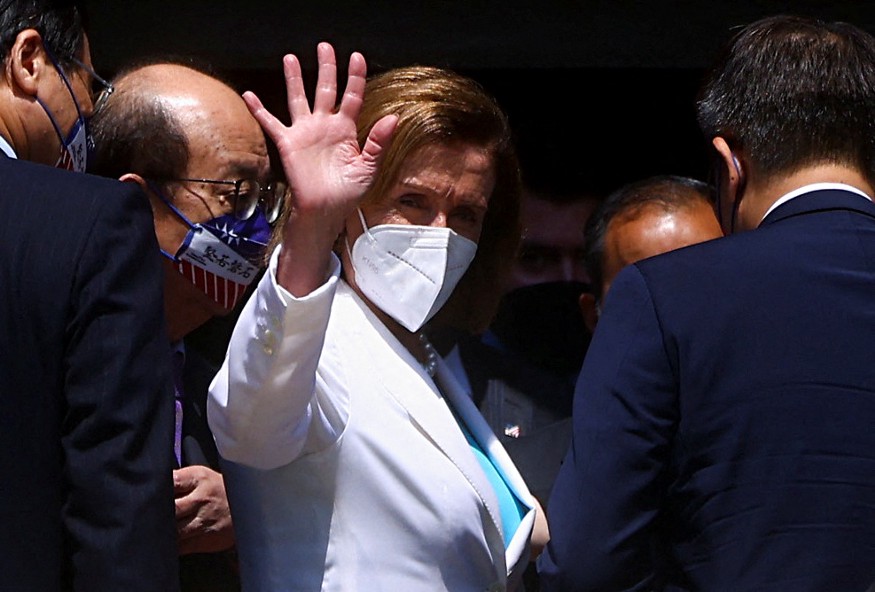
Interest in Pelosi visit skyrocketed on Weibo before news fatigue set in
United States House Speaker Nancy Pelosi’s arrival in Taiwan on August 2, 2022 marked the highest-ranking American official to visit the island in twenty-five years. On Chinese social media — including Weibo, which is similar to Twitter — interest in Taiwan and Pelosi skyrocketed, with millions of users participating in the discussion. The DFRLab analyzed Weibo trends before, during, and after Pelosi’s visit to document the evolution of the discussion on the platform. The DFRLab found that narratives pushed by Chinese state media and amplified by tabloid accounts dominated the discourse. We also found signs of possible news fatigue, as the arrival of a second US delegation eleven days later elicited a milder response on the platform.
Pelosi’s visit took place amid heightened tensions between China and Taiwan. Chinese President Xi Jinping has said that reunification with Taiwan “must be fulfilled,” even if it happens by force. Nevertheless, many Taiwanese citizens are accustomed to threats from mainland China. A part of this confidence stems from the expectation that the US will defend Taiwan from China, even though the US has not explicitly made this commitment. US interest in potentially supporting the Taiwanese government is partly due to the island’s strategic location in the Indo-Pacific, offering a possible balance against China. Taiwan’s semiconductor partnership with the US also helps foster the development of US technology. Taiwanese President Tsai Ing-wen is receptive to US cooperation and has previously welcomed American officials, as these visits lend credence to Taiwanese sovereignty. While China has always pushed back on US delegation visits, Pelosi’s trip to Taiwan generated a stronger response than usual. In turn, interest in Taiwan soared on Weibo.
To understand Weibo traffic related to Pelosi’s visit to Taiwan, the DFRLab analyzed more than 66,000 unique Weibo posts. The dataset includes posts that were published from April 1 to April 13, 2022, when Pelosi was first scheduled to visit Taiwan but had to cancel after contracting COVID-19, and July 12 to August 17, 2022, coinciding with the period surrounding her eventual visit. The majority of the posts analyzed were published from mid-July to mid-August. These posts all contained one of four keywords: Pelosi (佩洛西), Taiwan (台湾), People’s Liberation Army (解放军), or Eastern Theater (东部战区), referring to the Eastern Theater Command of the PLA, responsible for the Taiwan Strait.
The DFRLab found that Chinese state media led the charge in pushing narratives on Weibo by populating hashtags that undermined Pelosi and Taiwanese sovereignty, while reassuring the Chinese public that Beijing can deliver on reunification. One narrative claimed that Pelosi was shunned and opposed by both Taiwanese locals and Asian leaders. Another narrative amplified threats of Chinese military retaliation in the Taiwan Strait. The narratives spread by Chinese state media sought to display China’s control over the matter to domestic audiences, reassuring citizens that Taiwan is a Chinese territory.
Timing the visit
On April 6, 2022, US and Taiwanese media announced that Speaker Pelosi intended to visit Taiwan on April 10. Consequently, Chinese state media outlets CCTV and People’s Daily published official statements on April 7 that steered the discussion on Weibo. Abiding by its standard messaging, China’s Ministry of Defense claimed that “Taiwan is an inalienable part of China,” and urged the US “to abide by the one-China principle,” threatening military retaliation. In their posts, state media experimented with several hashtags. Soon after, tabloid news accounts such as Wuxinjianying (@无心简影) and Diba (@帝吧官微) amplified the hashtags. However, none of the hashtags reached the top of the Weibo trending charts.
The DFRLab visualized the number of likes received on Weibo posts containing one or more of the keywords in the weeks before and after the planned April trip. There was a small rise in discussion on April 7, but it paled in comparison to the engagement on posts about domestic politics. In April, China enacted a strict lockdown in Shanghai in an effort to achieve zero COVID cases. Our research shows that posts about the lockdown received significantly more engagement than posts about Pelosi’s visit. The largest peak in likes occurred on April 3 and was related to the PLA’s pandemic relief efforts in Shanghai. This exemplifies that in April there was a large gap in interest between domestic and foreign issues. On April 8, Pelosi canceled her trip after testing positive for COVID. Our research shows that after the announcement, interest in Taiwan rapidly declined from its relatively small peak. Given the preoccupation with domestic issues in China and the mild Weibo response to Pelosi’s announcement, it is possible that her visit would not have garnered the same reaction had she arrived in April.
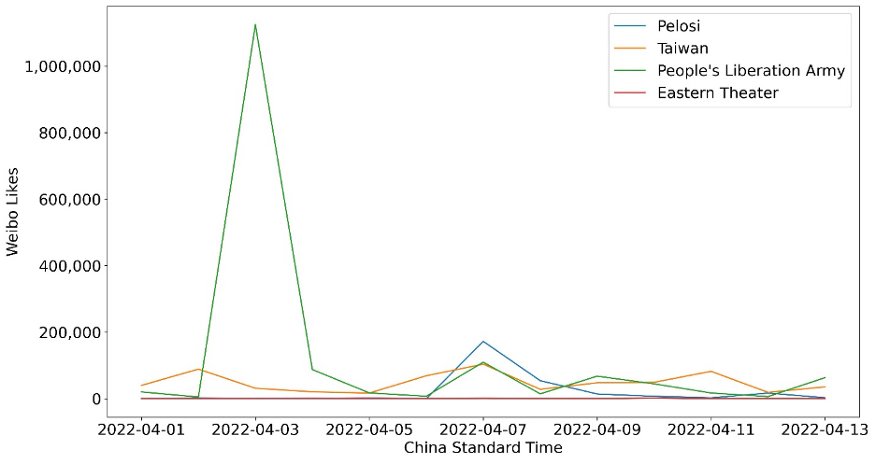
The DFRLab conducted the same analysis with data corresponding to Pelosi’s completed trip to Taiwan in August 2022. The sampled time frame was split into six periods of story development. When the speaker boarded her flight, likes received on relevant posts began to reach monumental heights, with some posts receiving ten times more likes than the April 7 peak. According to NetEase, the influx of traffic on Weibo triggered a temporary server shutdown on August 2, just as Pelosi’s plane landed. After Pelosi’s departure on August 3, interest in the topic increased rather than subsided. In the week following her departure, likes began to slowly recede.
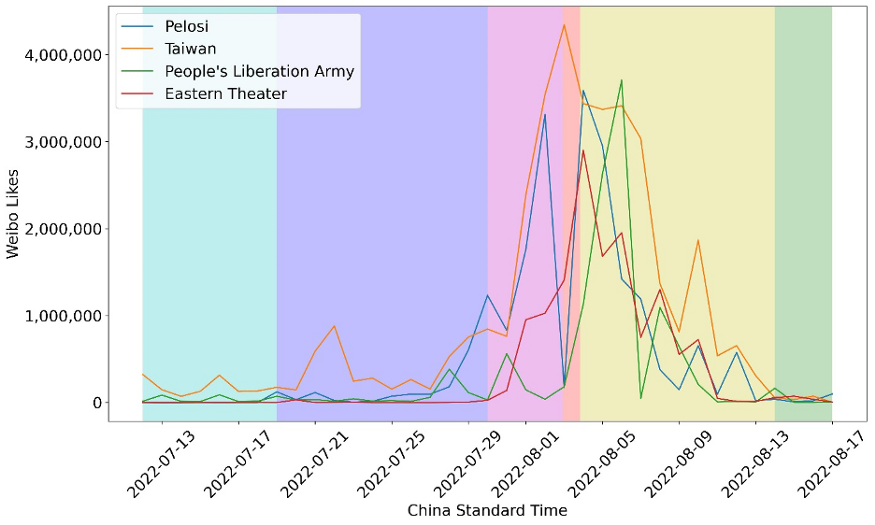
Conversations about Pelosi
The narratives that were amplified during Pelosi’s visit to Taiwan were reflected in the hashtags that reached the trending charts on Weibo. The DFRLab utilized Weibo Host Search Engine to query the historical trending hashtags on Weibo, ordered by engagement through its “popularity score.” In addition, the DFRLab combed through our database of posts mentioning the four keywords related to the Taiwan visit to identify the top hashtags by their performance metrics. The top hashtags differ at points from those on the Weibo’s trending chart because some trending hashtags did not contain the keywords the DFRLab queried. In addition, while the hashtags analyzed in this report reached the trending list, it does not mean that they were the top overall hashtags on Weibo, as entertainment-related hashtags frequently overtake political hashtags in popularity.
The following two tables contain Weibo hashtag data sourced from the Weibo Hot Search Engine and the DFRLab’s database respectively. The subsequent analysis makes frequent references to hashtags and metrics in these tables.
July 19-29, 2022: Speculation about Pelosi’s visit
In the period after Pelosi postponed her April trip, but before she announced her August trip, users on Weibo showed relatively minimal interest in the US House Speaker. On July 19, Financial Times, citing insider sources, reported that Pelosi would visit Taiwan soon. On the same day, the hashtag “China demands that the US not arrange for Pelosi to visit Taiwan” (中方要求美国不得安排佩洛西访台) began trending, reigniting conversations about Pelosi’s trip. However, reception to the hashtag was lukewarm, receiving only a little more than 1,000 cumulative reposts. In addition, when US President Joe Biden said the US military opposed the Taiwan trip, it seemed to have split the Democratic Party, yet the comments barely gained traction on Weibo; the corresponding hashtag, “The US military opposed the Taiwan trip” (美军方对佩洛西访台表示担忧), had just 483 reposts. The first truly viral post related to Taiwan during the speculation period was from state media outlet People’s Daily on July 28. The post was not about Pelosi, but discussed the Chinese defense ministry responding to US military spending in Taiwan. Although the post’s main hashtag was “Reunification of the motherland is the sacred mission of the PLA” (统一祖国是解放军的神圣使命), it also included the hashtag “Taiwan is China’s Taiwan” (台湾是中国的台湾), which served as the primary hashtag for discussions about Pelosi the next day, when interest in her trip picked up again.
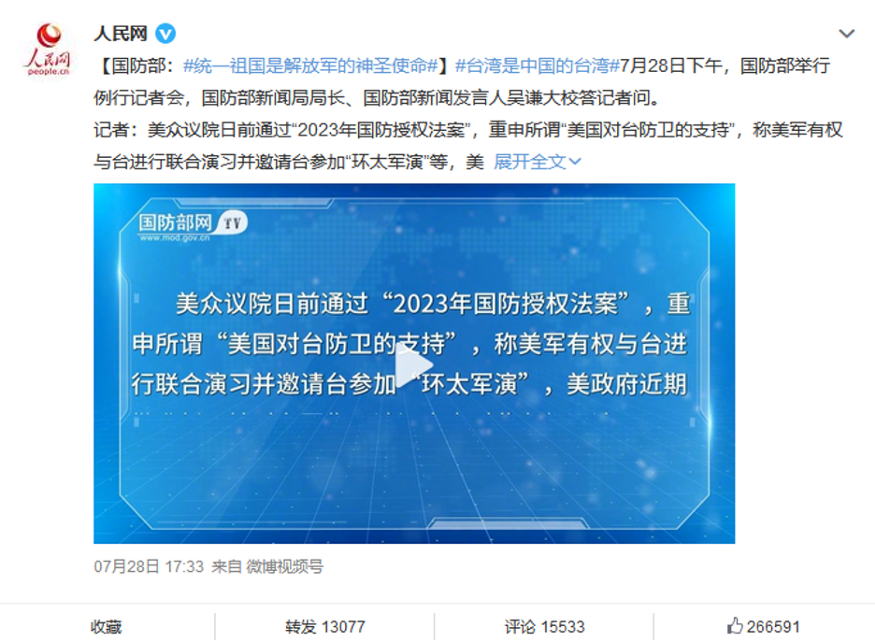
July 30-August 1, 2022: Pelosi heads to Asia
As Speaker Pelosi’s arrival neared, the tone of Weibo discussions became more threatening and hostile. Since Pelosi had never officially confirmed her trip, Chinese state media and Weibo users speculated, along with the rest of the international community, about whether she would actually land in Taiwan. State television network CCTV posted a short video clip of Foreign Ministry spokesperson Zhao Lijian saying, “If Pelosi dares to go to Taiwan, we will wait and see.” The “wait and see” was not referring to Pelosi, but to the “firm response and strong countermeasures” China would take. This phrase became the most engaged-with hashtag (若佩洛西敢去台湾那我们拭目以待), out of all the relevant hashtags, on the day before Pelosi landed in Taiwan.
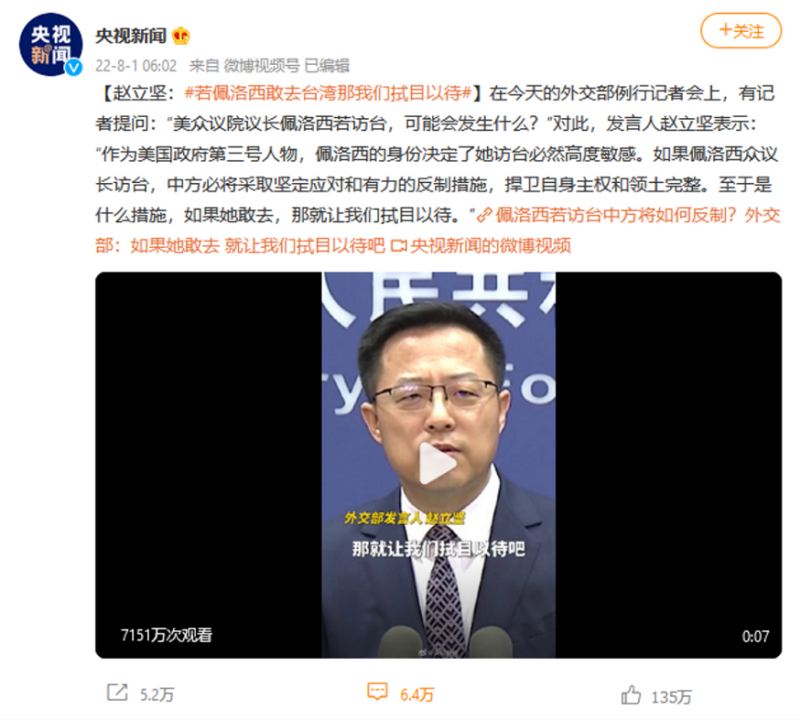
August 2–3, 2022: Pelosi arrives in Taiwan
On the day of Pelosi’s arrival, engagement on hashtags opposing her visit began to soar, pushing the hashtags to their peak in popularity. On August 2, Taiwan’s Taoyuan airport, the busiest in the country, received a bomb threat. The “Taoyuan Airport receives explosive threat letter” hashtag (桃园机场收到爆裂物恐吓信), promoted by Global Times, received a cumulative 822,610 likes. Rather than associating the threat with opposition to Pelosi, the top comments on the post inferred that the threat was a false flag “self-directed” by Taiwan so it can claim China conducts terror attacks.
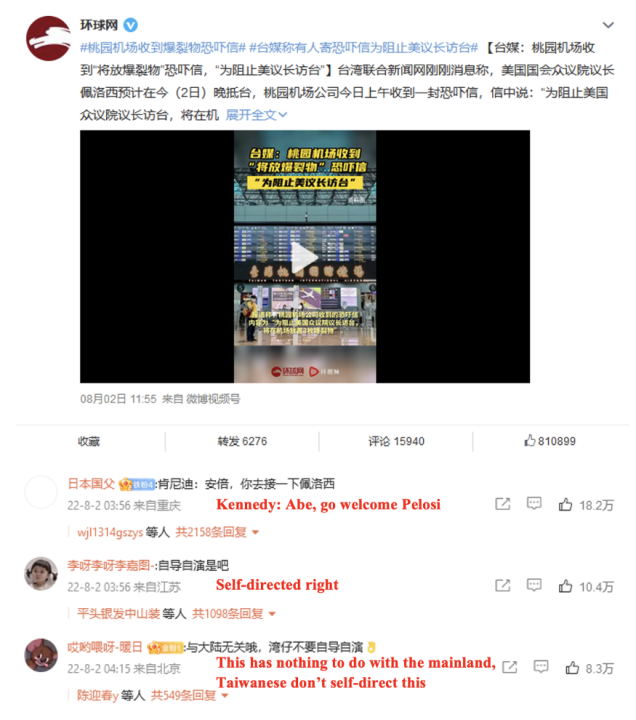
Another viral post from the day of Pelosi’s arrival was published by state media outlet China News Service. The post featured a video of a small anti-Pelosi protest outside a Taiwanese restaurant with claims that over one thousand police officers were deployed to contain the protesters. This post painted a picture of forceful opposition to Pelosi and a strong Taiwanese yearning to reunify with China.

Approximately thirty minutes before Pelosi landed, CCTV reported on Weibo that China’s Ministry of Commerce would suspend natural sand exports to Taiwan. According to Sina Finance, Taiwan imports over 95 percent of its natural sands, used as an industrial material, from China. The hashtag related to this announcement, “Suspending natural sand exports to Taiwan” (对台湾地区暂停天然砂出口), trended on August 3; while China suspended several imports in retaliation, this was the only form of economic retaliation to trend on Weibo. In the DFRLab’s database, this is the hashtag that received the most amount of likes during Pelosi’s visit. This hashtag also marked the beginning of the shift in attention away from Pelosi towards Chinese retaliatory measures. This is visible in the previous line graph, where likes on “Pelosi” posts dip to a low on August 3.
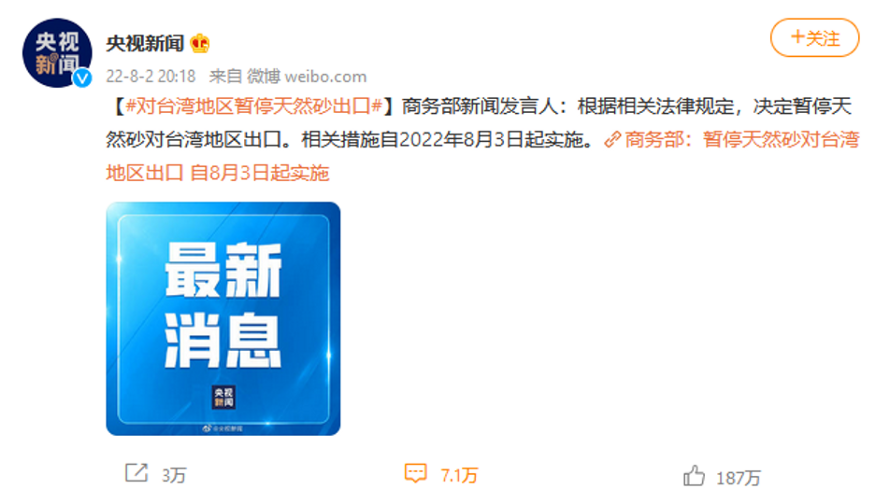
August 4–8, 2022: Pelosi departs Taiwan
As the world watched to see if Beijing’s retaliatory threats would come to fruition following Pelosi’s departure on August 3, anti-US narratives continued to spread on Weibo. One narrative chastised locals and world leaders who did not condone the visit. The trending hashtags implied that Korea and Japan did not support Pelosi or her agenda. In addition, another narrative offering reassurances to the Chinese public began to emerge. Hashtags related to the PLA and the Eastern Theater Command reached their peaks on August 6 and August 3 respectively, according to DFRLab’s dataset, reflecting Beijing’s need to enact consequences for Pelosi not heeding previous warnings.
According to the DFRLab’s database, many of the top shared and liked posts about Pelosi’s visit occurred after she left Taiwan. A post by People’s Daily on August 10, directed at Taiwanese residents, featured an image that read “be a dignified Chinese.” The replies to the post were overly simplistic and agreeable, and many of the commenters had an IP address in Hong Kong or Taiwan; this could indicate that inauthentic accounts were used to imitate China supporters and inflate engagement metrics.

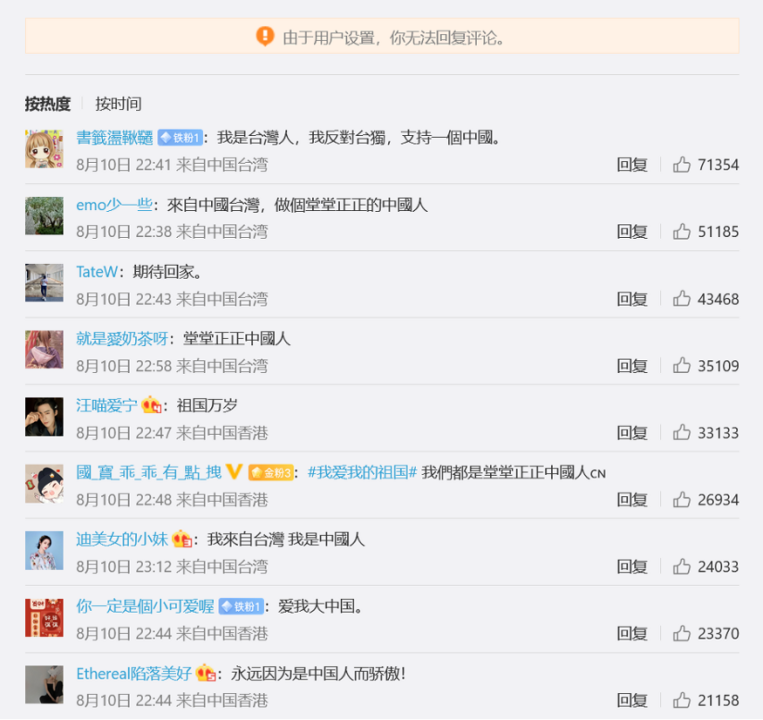
In addition, a widely shared news post highlighted comments from Pink Floyd’s Roger Waters, who told CNN, “Taiwan is a part of China, and that has been absolutely accepted by the whole of the international community since 1948.” He also said, “if you don’t know that, you are not reading enough.” This comment was amplified by the Global Times through the hashtag “Read more books if you don’t know that Taiwan is a part of China” (不知道台湾是中国的一部分就去读书), which became the top trending topic on August 8. As both a celebrity and a British national, Waters was used as evidence that international voices support China reunifying with Taiwan. This serves as another example of Chinese state media leveraging influencers to push narratives.
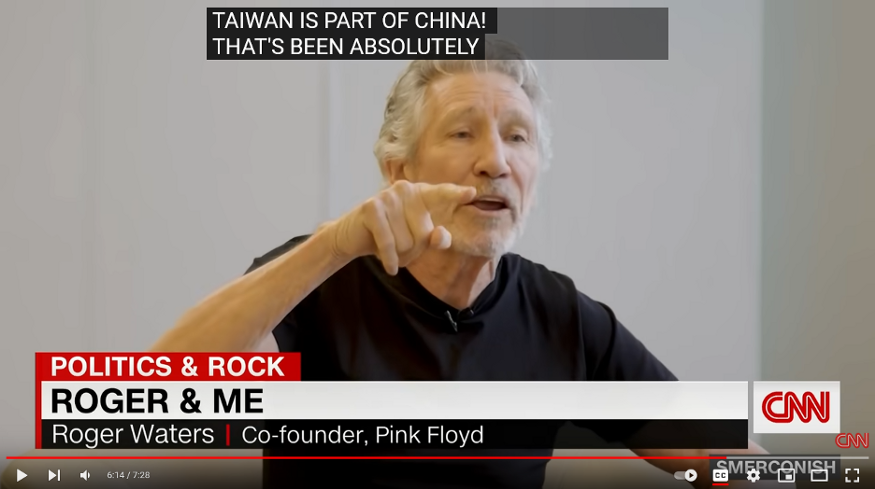
Another top post featured a declaration from Chinese Foreign Minister Wang Yi, also made after Pelosi’s departure. He reiterated the importance of the One-China Principle and attacked President Tsai, calling her an “unworthy descendant” of the Republic of China’s founding father Sun Yat-sen. The corresponding hashtag, “unworthy descendant Tsai Ing-wen” (不肖子孙蔡英文), marked the first time the Taiwanese president was mentioned in a trending hashtag.
The unusually high degree of amplification on the narratives surrounding Pelosi’s visit could be interpreted as a way for Beijing to reassure the domestic public that national interests were protected, and the status quo remains intact following the “provocations” from the US.
August 14–17: Second US delegation arrives
Following Pelosi’s trip, a second delegation of high-level US lawmakers arrived in Taiwan on August 14. The main hashtag related to this trip was, “more US members of Congress visit Taiwan” (又有美国国会参众议员窜访台湾). It did reach the top of the Weibo trending list, but dropped off the trending list within 96 minutes. In comparison, other trending topics that day stayed on for list for upwards of 956 minutes. The following day, no related hashtags reached the top trends list. This decline in interest is also reflected in the DFRLab’s database. The best performing post was about a military patrol, and only received a fraction of the engagement that was seen during Pelosi’s visit. This may be an indicator that news fatigue had set in, or that there was a degree of normalization, with Weibo users not reacting as strongly to second American diplomatic visit.
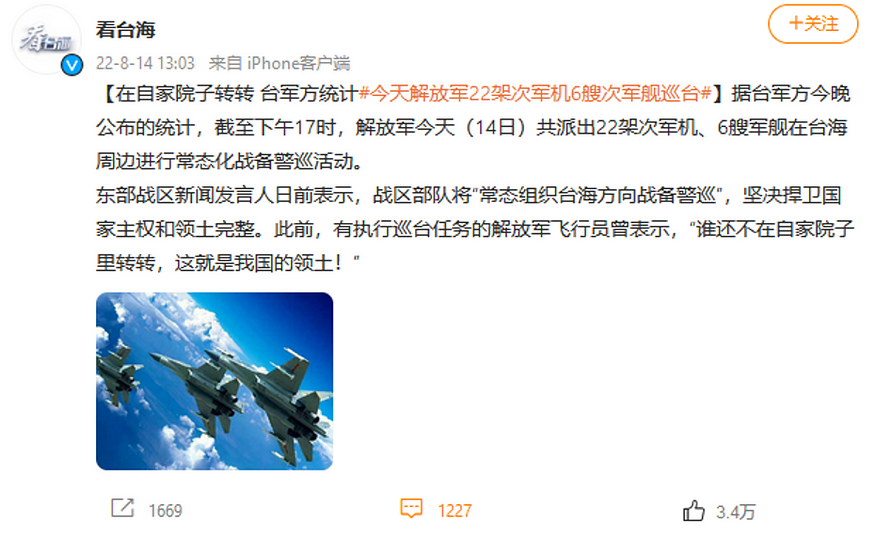
The DFRLab’s examination of Chinese Weibo trends during Pelosi’s visit to Taiwan indicates an unusually high level of interest in the topic, with tremendous amounts of traffic and engagement on posts related to the visit. China used trending hashtags to attack Pelosi and her allies, boast its military capabilities, and reassure Chinese citizens of eventual reunification. Further, as we saw, Chinese state media accounts were used to popularize hashtags that promoted state narratives, then tabloid accounts were used to further amplify these narratives, this exemplifies the synergy of China’s digital strategy.
Cite this case study:
“How Chinese social media reacted to Nancy Pelosi’s Taiwan visit,” Digital Forensic Research Lab (DFRLab), September 13, 2022, https://medium.com/dfrlab/how-chinese-social-media-reacted-to-nancy-pelosis-taiwan-visit-b70ff0bfe1b9.

